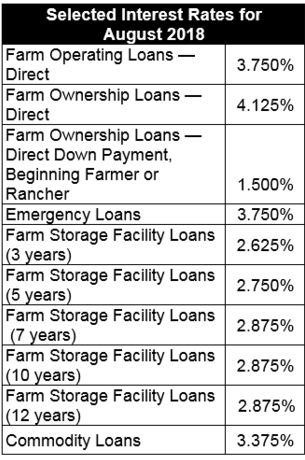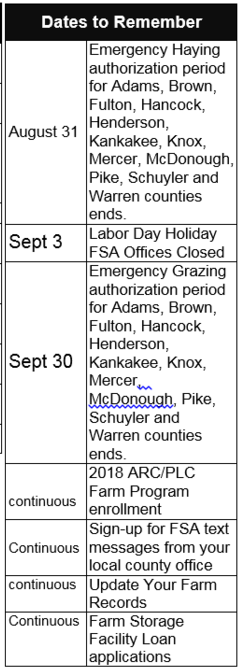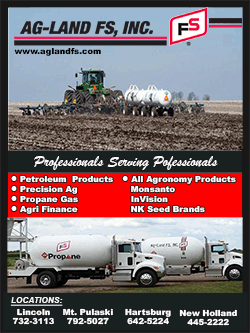|
 Obernagel will join the current State Committee who were
appointed in January of this year; State Committee Chairperson
Jim Reed of DeLand and Committee members Melanie DeSutter of
Woodhull ; Troy Uphoff of Findlay. The State Committee are
responsible for the oversight of farm programs and county
committee operations, resolving appeals from the agriculture
community, and helping to keep producers informed about FSA
programs. Obernagel will join the current State Committee who were
appointed in January of this year; State Committee Chairperson
Jim Reed of DeLand and Committee members Melanie DeSutter of
Woodhull ; Troy Uphoff of Findlay. The State Committee are
responsible for the oversight of farm programs and county
committee operations, resolving appeals from the agriculture
community, and helping to keep producers informed about FSA
programs.
Obernagel is the owner of his family farm and is very familiar
with the agriculture industry and USDA programs. He earned his
Bachelor's Degree from McKendree University in Lebanon,
Illinois.
For over 25 years Obernagel worked for community banks holding
such positions as Vice President; Trust Officer; and Farm
Manager.
Welcome back George!
William J. Graff
State Executive Director
Using FSA Direct Farm Ownership Loans for Construction
The USDA Farm Service Agency’s (FSA) Direct Farm Ownership loans
are a resource to help farmers and ranchers become
owner-operators of family farms, improve and expand current
operations, increase agricultural productivity, and assist with
land tenure to save farmland for future generations.

Depending on the applicant’s needs, there are three types of
Direct Farm Ownership Loans: regular, down payment and joint
financing. FSA also offers a Direct Farm Ownership Microloan
option for smaller financial needs up to $50,000.
Amongst other purposes, Direct Farm Ownership Loans can be used
to construct, purchase or improve farm dwellings, service
buildings or other facilities and improvements essential to an
operation.
To do this, applicants must provide FSA with an estimate of the
total cost of all planned development that completely describe
the work, prior to loan approval and must show proof of
sufficient funds to pay for the total cost of all planned
development at or before loan closing. In some instances,
applicants may be asked to provide certified plans,
specifications or contract documents. The applicant cannot incur
any debts for materials or labor or make any expenditures for
development purposes prior to loan closing with the expectation
of being reimbursed from FSA funds.
Construction and development work may be performed either by the
contract method or the borrower method. Under the contract
method, construction and development contractors perform work
according to a written contract with the applicant or borrower.
An applicant for a direct loan to finance a construction project
must obtain a surety bond that guarantees both payment and
performance in the amount of the construction contract from a
construction contractor.
A surety bond is required when a contract exceeds $100,000, an
authorized agency official determines that a surety bond appears
advisable to protect the borrower against default of the
contractor or a contract provides for partial payments in excess
of the amount of 60 percent of the value of the work in place.
Under the borrower method, the applicant or borrower will
perform the construction and development work. The borrower
method may only be used when the authorized agency official
determines, based on information from the applicant, that the
applicant possesses or arranges to obtain the necessary skill
and managerial ability to complete the work satisfactorily and
that such work will not interfere with the applicant’s farming
operation or work schedule.
Potential applicants should visit with FSA early in the initial
project planning process to ensure environmental compliance.
For more eligibility requirements and information about FSA Loan
programs, contact your local FSA office or visit
www.fsa.usda.gov. To find your local FSA office, visit
http://offices.usda.gov.

Actively Engaged Provisions for Non-Family Joint Operations
or Entities
Many Farm Service Agency programs require all program
participants, either individuals or legal entities, to be
“actively engaged in farming.” This means participants provide a
significant contribution to the farming operation, whether it is
capital, land, equipment, active personal labor and/or
management. For entities, each partner, stockholder or member
with an ownership interest, must contribute active personal
labor and/or management to the operation on a regular basis.
Joint operations comprised of non-family members or partners,
stockholders or persons with an ownership in the farming
operation must meet additional payment eligibility provisions.
Joint operations comprised of family members are exempt from
these additional requirements. For 2016 and subsequent crop
years, non-family joint operations can have one member that may
use a significant contribution of active personal management
exclusively to meet the requirements to be determined “actively
engaged in farming.” The person or member will be defined as the
farm manager for the purposes of administering these management
provisions.
Non-family joint operations may request to add up to two
additional managers for their farming operation based on the
size and/or complexity of the operation. If additional farm
managers are requested and approved, all members who contribute
management are required to complete form CCC-902MR, Management
Activity Record. The farm manager should use the form to record
management activities including capital, labor and agronomics,
which includes crop selection, planting decisions, acquisition
of inputs, crop management and marketing decisions. One form
should be used for each month and the farm manager should enter
the number of hours of time spent for each activity under the
date of the month the actions were completed. The farm manager
must also document if each management activity was completed on
the farm or remotely.
The records and supporting business documentation must be
maintained and timely made available for review by the
appropriate FSA reviewing authority, if requested.
If the farm manager fails to meet these requirements, their
contribution of active personal management to the farming
operation for payment eligibility purposes will be disregarded
and their payment eligibility status will be re-determined for
the applicable program year.
In some instances, additional persons or members of a non-family
member joint operation who meet the definition of farm manager
may also be allowed to use such a contribution of active
personal management to meet the eligibility requirements.
However, under no circumstances may the number of farm managers
in a non-family joint operation exceed a total of three in any
given crop and program year.

More information on “Actively Engaged in Farming” can be found
online at
https://
www.fsa.usda.gov/programs-and-services/paymenteligibility/actively_
engaged/index.
ARC/PLC Acreage Maintenance
Producers enrolled in the Agriculture Risk Coverage (ARC) or
Price Loss Coverage (PLC) programs must protect all cropland and
noncropland acres on the farm from wind and water erosion and
noxious weeds. Producers who sign ARC county or individual
contracts and PLC contracts agree to effectively control noxious
weeds on the farm according to sound agricultural practices. If
a producer fails to take necessary actions to correct a
maintenance problem on a farm that is enrolled in ARC or PLC,
the County Committee may elect to terminate the contract for the
program year.
A copy of ARC/PLC Enrollment Contract Appendix, which sets forth
terms and conditions of the ARC and PLC program, can be found at
https://www.fsa.usda.gov/Assets/
USDA-FSAPublic/usdafiles/arcplc/pdf/
ccc861andccc862_appendix_a77a.pdf.
Reporting Solar Panels or Wind Turbines Constructed on
Cropland
Producers who have solar panels or wind turbines constructed on
their farms should notify the local Farm Service Agency Office.
Any area that is no longer considered suitable as cropland
(producing annual or perennial crops) should be designated in
FSA’s records and aerial photography maps. When base acres on a
farm are converted to a non-agricultural commercial or
industrial use, the total base acres on the farm must be reduced
accordingly. Non-cropland areas used for solar panels might
impact payments calculated using base acres, such as Agriculture
Risk Coverage (ARC) and Price Loss Coverage (PLC) and
Conservation Reserve Program (CRP) annual rental payments.
USDA Microloans Help Farmers Purchase Farmland and Improve
Property
Producers, Including Beginning and Underserved Farmers, Have a
New Option to Gain Access to Land
The U.S. Department of Agriculture (USDA) is offering farm
ownership microloans, creating a new financing avenue for
farmers to buy and improve property. These microloans are
especially helpful to beginning or underserved farmers, U.S.
veterans looking for a career in farming, and those who have
small and mid-sized farming operations.
The microloan program has been hugely successful, providing more
than 16,800 low-interest loans, totaling over $373 million to
producers across the country. Microloans have helped farmers and
ranchers with operating costs, such as feed, fertilizer, tools,
fencing, equipment, and living expenses since 2013. Seventy
percent of loans have gone to new farmers.
Now, microloans will be available to also help with farm land
and building purchases, and soil and water conservation
improvements. FSA designed the expanded program to simplify the
application process, expand eligibility requirements and
expedite smaller real estate loans to help farmers strengthen
their operations. Microloans provide up to $50,000 to qualified
producers, and can be issued to the applicant directly from the
USDA Farm Service Agency (FSA).
To learn more about the FSA microloan program visit
www.fsa.usda.gov/microloans, or contact your local FSA office.
Farm Storage Facility Loans
FSA’s Farm Storage Facility Loan (FSFL) program provides
low-interest financing to producers to build or upgrade storage
facilities and to purchase portable (new or used) structures,
equipment and storage and handling trucks.

The low-interest funds can be used to build or upgrade permanent
facilities to store commodities. Eligible commodities include
corn, grain sorghum, rice, soybeans, oats, peanuts, wheat,
barley, minor oilseeds harvested as whole grain, pulse crops
(lentils, chickpeas and dry peas), hay, honey, renewable
biomass, fruits, nuts and vegetables for cold storage
facilities, floriculture, hops, maple sap, rye, milk, cheese,
butter, yogurt, meat and poultry (unprocessed), eggs, and
aquaculture (excluding systems that maintain live animals
through uptake and discharge of water). Qualified facilities
include grain bins, hay barns and cold storage facilities for
eligible commodities.
Loans up to $100,000 can be secured by a promissory
note/security agreement. Loans exceeding $100,000 require
additional security.
Producers do not need to demonstrate the lack of commercial
credit availability to apply. The loans are designed to assist a
diverse range of farming operations, including small and
mid-sized businesses, new farmers, operations supplying local
food and farmers markets, non-traditional farm products, and
underserved producers.
To learn more about the FSA Farm Storage Facility Loan, visit
www.fsa.usda.gov/pricesupport or contact your local
FSA county office. To find your local FSA county office, visit
http://offices.usda.gov.
Marketing Assistance Available for 2018 Crops
The 2014 Farm Bill authorized 2014-2018 crop year Marketing
Assistance Loans (MALs) and Loan Deficiency Payments (LDPs).
MALs provide financing and marketing assistance for 2018 crop
wheat, feed grains, soybeans and other oilseeds, pulse crops,
wool and honey. MALs provide producers interim financing after
harvest to help them meet cash flow needs without having to sell
their commodities when market prices are typically at
harvest-time lows.
A producer who is eligible to obtain an MAL, but agrees to forgo
the loan, may obtain an LDP if such a payment is available.
To be eligible for an MAL or an LDP, producers must have a
beneficial interest in the commodity, in addition to other
requirements. A producer retains beneficial interest when
control of and title to the commodity is maintained. For an LDP,
the producer must retain beneficial interest in the commodity
from the time of planting through the date the producer filed
Form CCC-633EZ (page 1) in the FSA County Office. For more
information, producers should contact their local FSA county
office or view the LDP Fact Sheet.
Unauthorized Disposition of Grain
If loan grain has been disposed of through feeding, selling or
any other form of disposal without prior written authorization
from the county office staff, it is considered unauthorized
disposition. The financial penalties for unauthorized
dispositions are severe and a producer’s name will be placed on
a loan violation list for a two-year period. Always call before
you haul any grain under loan.
USDA Authorizes Emergency Haying and Grazing of Conservation
Reserve Program Acres for Illinois Counties
Currently, Adams, Brown, Fulton, Hancock, Henderson, Kankakee,
Knox, Mercer, McDonough, Pike, Schuyler, and Warren Counties
have received emergency haying and grazing approval. The
emergency grazing period for these counties will begin on August
2 and end September 30, 2018. The emergency haying authorization
for these counties will begin on August 2 and end on August 31,
2018.
[to top of second column] |

Eligible producers who are interested in emergency haying and
grazing of CRP must request approval before haying and grazing
eligible acreage and must obtain a modified conservation plan
from the Natural Resources Conservation Service that includes
haying and grazing provisions. Current provisions allow grazing
on 75 percent of a field, at no more than 75 percent of the
stocking rate. Haying provisions require producers leave at
least 50 percent of each field unhayed.
Eligible practices for emergency haying and grazing are CP1,
CP2, CP4D, CP10, and CP38E. There will be no CRP annual rental
payment reduction for 2018 emergency haying and grazing
authorizations.
To take advantage of the emergency grazing provisions,
authorized producers can use the CRP acreage for their own
livestock or may grant another livestock producer use of the CRP
acreage. The eligible CRP acreage is limited to acres located
within the approved county.
In counties that are authorized for emergency haying and
grazing, producers are reminded that the same CRP acreage cannot
be both hayed and/or grazed at the same time. For example, if 50
percent of a field or contiguous field is hayed, the remaining
unhayed 50 percent cannot be grazed; it must remain unhayed and
ungrazed for wildlife. In addition, participants are limited to
one hay cutting and are not permitted to sell any of the hay.
For more information and to request approval for emergency
haying or grazing use of CRP acres, contact the Adams, Brown,
Fulton, Hancock, Henderson, Kankakee, Knox, Mercer, McDonough
Pike, Schuyler, and Warren County FSA Offices.
Report Noninsured Crop Disaster Assistance Program (NAP)
Losses
The Noninsured Crop Disaster Assistance Program (NAP) provides
financial assistance to producers of non-insurable crops when
low yields, loss of inventory, or prevented planting occur due
to natural disasters including freeze, hail, excessive moisture,
excessive wind or hurricanes, flood, excessive heat and
qualifying drought (includes native grass for grazing), among
others.
Eligible producers must have purchased NAP coverage for 2018
crops. A notice of loss must be filed the earlier of 15 days of
the occurrence of the disaster or when losses become apparent or
15 days of the final harvest date.
Producers of hand-harvested crops and certain perishable crops
must notify FSA within 72 hours of when a loss becomes apparent.

Eligible crops must be commercially produced agricultural
commodities for which crop insurance is not available, including
perennial grass forage and grazing crops, fruits, vegetables,
mushrooms, floriculture, ornamental nursery, aquaculture, turf
grass, ginseng, honey, syrup, bioenergy, and industrial crops.
For more information on NAP, contact your local FSA office or
visit www.fsa.usda.gov/nap.
Application for Non-Insured Crop Disaster Assistance Program
(NAP) Payment
Producers must file an application for payment on form CCC-576
“Notice of Loss and Application for Payment”, Parts D, E, F, and
G, as applicable, to apply for payments within 60 days of the
last day of coverage for the crop year for any NAP covered crop
in the unit. For annual crops, the coverage period ends the
earlier of the:
Date the crop harvest is complete
Normal harvest date for the crop
Date the crop is abandoned, or
Date the crop acreage is destroyed.
Eligible crops must be commercially produced agricultural
commodities for which crop insurance is not available, including
perennial grass forage and grazing crops, fruits, vegetables,
mushrooms, floriculture, ornamental nursery, aquaculture, turf
grass, ginseng, honey, syrup, bioenergy, and industrial crops.
For more information on NAP, contact your local FSA office or
visit www.fsa.usda.gov/nap.
Emergency Disaster Declarations and Designations
Farmers and ranchers know all too well that natural disasters
can be a common, and likely a costly, variable to their
operation. The Farm Service Agency (FSA) has emergency
assistance programs to provide assistance when disasters strike,
and for some of those programs, a disaster designation may be
the eligibility trigger.
FSA administers four types of disaster designations:
USDA Secretarial Disaster Designation
The designation process can be initiated by individual farmers,
local government officials, State governors, State agriculture
commissions, tribal councils or the FSA State Executive Director
This designation is triggered by a 30-percent or greater
production loss to at least one crop because of a natural
disaster, or at least 1 producer who sustained individual losses
because of a natural disaster and is unable to obtain commercial
financing to cover those losses.

In 2012, USDA developed a fast-track process for disaster
declarations for severe drought. This provides for a nearly
automatic designation when, during the growing season, any
portion of a county meets the D2 (Severe Drought) drought
intensity value for eight consecutive weeks or a higher drought
intensity value for any length of time as reported by the U.S.
Drought Monitor (http://droughtmonitor.unl.edu)
Administrator’s Physical Loss Notification
This designation is initiated by the FSA State Executive
Director.
The designation is triggered by physical damage and losses
because of a natural disaster, including but not limited to dead
livestock, collapsed buildings, and destroyed farm structures.
Presidential Designation
A Presidential major disaster designation and emergency
declaration is initiated by the Governor of the impacted state
through the Federal Emergency Management Agency (FEMA).
This designation is triggered by damage and losses caused by a
disaster of such severity and magnitude that effective response
is beyond the capability of the State and local governments.
Quarantine Designation
This designation is requested of the Secretary of Agriculture by
the FSA State Executive Director.
A quarantine designation is triggered by damage and losses
caused by the effects of a plant or animal quarantine approved
by the Secretary under the Plant Protection Act or animal
quarantine laws.
All four types of designations immediately trigger the
availability of low-interest Emergency loans to eligible
producers in all primary and contiguous counties. FSA borrowers
in these counties who are unable to make their scheduled
payments on any debt may be authorized to have certain set
asides. Additional disaster assistance requiring a designation
may also be provided by new programs in the future.
For more information on FSA disaster programs and disaster
designations, visit www.fsa.usda.gov/disaster.
Conduct USDA Business Online by Creating an eAuthenication
Account
The Internet allows you, the customer, access to USDA
information 24 hours a day, seven days a week. You can fill out
and submit electronic forms (eForms) any time of the day or
night from anywhere you have Internet access. This new service
delivery option allows you to complete and file your own forms
or applications online, because your signature is already
electronically "on file."
Information submitted to the Federal Government remains safe and
secure because every customer has a unique User ID and password;
only authorized USDA employees can access your information. It's
safe, saves paper, saves a visit to your local USDA Service
Center and provides electronic tracking of all your USDA
transactions.

How to Sign Up for eAuth:
Begin the process by reviewing the information at the USDA
Website https://www.eauth.usda.gov. This website describes the
services available for Level 1 and Level 2 Accounts. Level 1 and
Level 2 accounts require that you have an email address so you
can register, create a customer profile, and be able to respond
to a confirmation email. Level 1 Accounts do not require you to
provide proof of your identity at a local USDA Service Center.
Level 1 Accounts provide limited access to certain USDA Web site
portals that require no authentication or authorization. A Level
2 Account does require a visit to a USDA Service Center with
proof of your identity. That is because a Level 2 account allows
you access to complete and submit documents and forms
electronically.
LEVEL 1 ACCOUNT
STEP 1. To obtain a Level 1 Account, you may self-register
online at www.eauth.egov.usda.gov.
Scroll down and click on the button that says “Sign Up for a
Level 1 Account.” Complete the brief customer profile.
STEP 2. You will receive a confirmation email, and you must
respond to it within 7 days to activate your account.
LEVEL 2 ACCOUNT
STEP 1. To obtain a Level 2 Account, you must complete an 18
question customer profile and prove your identity by presenting
state or federal photo ID at a local USDA Service Center. Go to
www.eauth.egov.usda.gov, scroll down and click on “Sign Up for a
Level 2 Account.” Complete your customer profile, which includes
designating your user ID and password created by you, contact
information and email information. The data you enter in your
customer profile must match the data on the document you use as
identification at your local USDA Service Center. Example: Your
first and last names and address must match the
government-issued photo ID you plan to use to prove your
identity. Identify proof can only be verified by one of the
following documents: Current State Driver’s License, State Photo
ID, US Military ID, or United States Passport.
STEP 2. After completing your customer profile and submitting it
online, you will receive a confirmation email, and you must
respond to it within 7 days to activate your account.
STEP 3. Then you must complete the “Identify Proofing” process
by visiting a local USDA Service Center. You will be required to
present the eligible photo ID to an USDA employee who will
verify your identity and enter the expiration date of the ID
document used.
STEP 4. The USDA employee then will update your customer profile
to a Level 2 Account. You will have access to USDA online
applications and forms within one hour of your account being
updated.
You now have access to complete and submit documents and forms
electronically. USDA continues to update and make more forms and
programs available electronically.
August Interest Rates and Important
Dates to Remember


Illinois Farm Service Agency
3500 Wabash Ave.
Springfield, IL 62711
Phone: 217-241-6600
Fax: 855-800-1760
www.fsa.usda.gov/il
State Executive Director:
William J. Graff
State Committee:
James Reed-Chairperson
Melanie DeSutter-Member
George Obernagel III-Member
Troy Uphoff-Member
Executive Officer:
Rick Graden
Administrative Officer:
Dan Puccetti
Division Chiefs:
Doug Bailey
John Gehrke
Randy Tillman
To find contact information for your local office go to
www.fsa.usda.gov/il
 |